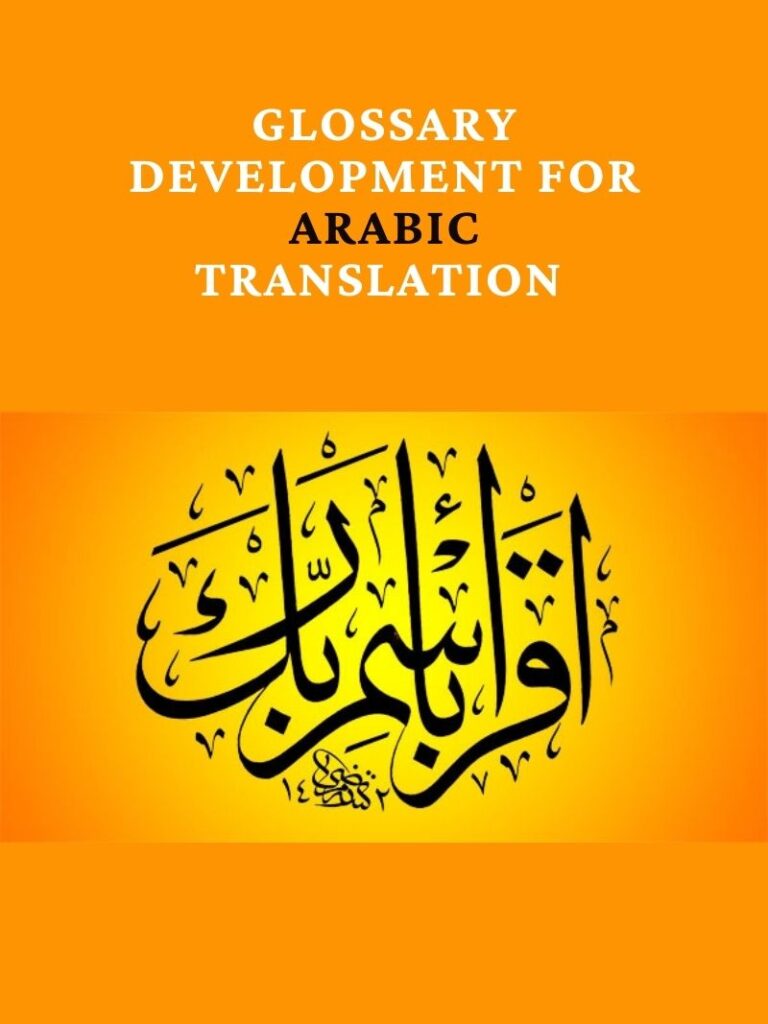
In order to answer the question of why Glossary is essential for translation projects into Arabic. Let’s first share some definitions like what is Glossary? The difference between glossary and translation memory, what type of terms to extract? Glossary structure, and benefits. Then we can go into more detail to explain the Arabic case.
What is Glossary?
A list of terms and short expressions specific to a client or to an industry. You develop the glossary, translate it, and approve it before starting the translation process. This is important to make sure you are using the correct terminologies all over the translation. Once done, you can always edit and update it and search for terms during the translation process. There are many commercial tools or even in-house developed software to facilitate working with glossaries. Also, you can measure the quality of a final translation by its adherence to the terms saved in the glossary. A glossary is a trustable reference for the translator in a translation project.
Difference between Glossary and Translation Memory
While Translation Memory stores the segments of a translation, the Glossary contains only pre-defined short terms of certain words only. Also, a glossary is prepared and approved before starting the translation of the actual content and can be maintained and updated later. The Translation Memory is developed during the translation process itself. A term stored in a glossary means that it was researched enough. already used and also approved.
What terms to extract for a glossary?
The glossary terms have one or more of the following characteristics:
- Terms that require clarifications because they are used in a meaning that is different from usual.
- Brand and product names.
- The words that should not be translated.
- Technical, scientific, or legal terms.
- Abbreviations.
- Any other unique terminologies related to a domain or a brand.
Glossary Structure
The glossary structure is a combination of more or less of the following sections:
- Source & target languages.
- The explanation that provides more details about the term like why to use it this way, where to use it and where not, capitalizations, etc…
- Related comments.
- Dates of addition, updates, acceptance (versioning).
- Reviewers names.
Glossary Benefits
- Maintain the consistency of the overall translation which will increase the quality.
- Makes it easy to understand the context of the terms and then translate it correctly.
- Create a common understanding between the client and the translation company and prevent misunderstanding.
- Accelerate the translation process by reducing the research time to select the best translation that matches certain repeated terms.
- Reduce ambiguity and uncertainty.
- Can be used as an acceptance criterion of the translation.
- During the Linguistic QA, the glossary facilitates the process of discovering translation issues.
The importance of glossary for Arabic translation projects
As mentioned, a translation glossary is very important to ensure the accuracy of the overall translation but it has a crucial role when the target language is not written in Latin script like Arabic for example.
Arabic diacritics
We write the Arabic Script from right to left while the numbers are written from left to right. Also, the Arabic Script uses some optional diacritics as in the below figure. These diacritics are used optionally to clarify the meaning and the pronunciation of certain words. These words can be agreed upon and stored in a glossary to be applied for the whole translated content.

Consonantal Alphabet
Also, The Arabic Script is a consonantal alphabet. This means no written vowels! For Arabic native speakers, this is not an issue as the reader can easily pronounce a word and understand it based on the context where it is written. And in traditional Arabic, the vowels are expressed using certain symbols (the ones highlighted in the above figure). But what about an Arabic Translation for a Natural Language Processing project? The computer cannot understand the word the way the human can. A well-prepared glossary can help the machine to have a better understanding of the different meanings of a single word in Arabic.
Arabic Dialects
And the fact that Arabic is the first language in the Middle East and North Africa, this doesn’t mean that the Modern Standard Arabic is the best choice to use for all the countries there. There are different dialects based on the country or the area, like Gulf Countries, Egypt, North Africa. A pre-defined agreement between the translator and the client about the Arabic locale and its related terminologies is very important. And to make sure they are used consistently in the whole translation project, they need to be stored in a glossary.
Terminologies
Also, using a glossary is very useful when the translation is related to the engineering or the medical domains. A lot of terminologies in these fields are usually kept in English. Therefore, including them in the main glossary of the translation project is important.
Arabic Letters
Furthermore, the Arabic language is distinguished from other languages by certain characteristics such as letter marks that can be added over or under letters like:

Such kind of a language specialty makes it more complex and then needs more collaboration and research. The glossary can save time here by doing the effort one time at the beginning of the project then store the result in a glossary and get it approved. Then, apply it during the translation process instead of keeping doing research for complex words during the translation process itself.
Conclusion:
The glossary should be always created before any translation and should be maintained and updated to keep it relevant. Translators must study, understand, and follow strictly the glossary during the translation then finally during the linguistic QA the glossary must be used as an acceptance factor for the final approval.
Feel free to leave a comment or to Contact Me for an open discussion!
